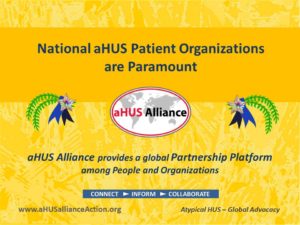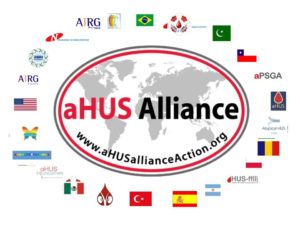Making the Case for the Value of Each

One of the most important roles of the aHUS Alliance is sharing a global focus on the collaborative nature of atypical HUS research and of aHUS advocacy. Creating improvements in disease management, determining clinical guidelines, and deepening of the aHUS knowledge base can advance more rapidly when people and groups work together.
Each country has highly individualized approaches to healthcare, and government policy often drives medical care and treatment options. There are wide variations within and among nations concerning hospital funding and patient insurance coverage, which additionally affect medical care – especially for those with a very rare disease such as atypical HUS (atypical hemolytic uremic syndrome, or aHUS). These aspects make it even more impressive when academics and clinicians work together to outline consensus on ‘best practices’, conduct nation-specific research, or participate in global efforts that provide data which may improve patient outcomes. (See KDIGO Conclusions and Physician Reference Guide for aHUS and C3G)
We’ve compiled a few examples of nation-specific research regarding atypical HUS, many of which cite publications which illustrate the global importance of collaboration. The aHUS Alliance would be remiss in not mentioning that many more nation-centric publications exist, to include case studies which by nature are also nation-specific. There are many fine physicians around the world who have joined together into ‘working groups’, as well as regional medical conferences which offer robust agendas with an impressive array of international speakers. Joining resources and data can be key elements in fostering progress, but imports efforts may also be centered in one country. There national aHUS research studies such as the Dutch CUREiHUS study (NTR5988), There are nation-specific clinical trials to include atypical HUS patients such as: the Australia/New Zealand clinical trial of Amgen biosimilar ABP959 (ANZCTR Reg No: ACTRN12616000509460), the France-based STOPECU (ClinicalTrials.gov ID: NCT02574403), the Japanese-based early clinical trial on eculizumab safety and effectiveness (ClinicalTrials.gov Identifier: NCT01757431), and in the USA for OMS721 (ClinicalTrials.gov ID: NCT03205995).
Many dedicated medical professionals around the world make contributions in the aHUS arena which encompass ‘clinician-researcher’ but they may also assume roles of ‘clinical trial investigator’ and ‘contributing author’. Atypical HUS advocates in some nations are fortunate enough to have patient education and outreach brought to their region, either by clinical/research experts or through an aHUS patient organization. Other nations have aHUS patient groups who work long and hard to create national meetings for atypical HUS families, which offer an opportunity to share support and to gain information from a team of professionals with expertise in multiple aspects of aHUS care and genetics.
Present it how you will, there’s no dispute that the national voice of patients and physicians should be paramount when discussing experiences, challenges, and opportunities in the aHUS space. Clinical practice and aHUS research is organized differently in each nation, as the aHUS Alliance noted in our July 2018 Whistle Stop tour of 4 aHUS expert centers in 3 nations (Paris, Newcastle UK, Milan and Bergamo Italy). Viewpoints as well as information needs to be regularly shared across nations and among stakeholders, and with patient and physician views to be seen as a valued and key component for industry and policy-makers as well.
aHUS Publications: Examples of Country-Specific Research
Important Note: The following is merely a sampling, rather than a comprehensive listing of national aHUS research efforts. Much aHUS research is done by international teams, and case studies are nation specific by nature.
Looking for more aHUS research on specialized topics? FMI & Tips, see our article
Australia (and New Zealand)
Consensus opinion on diagnosis and management of thrombotic microangiopathy in Australia and New Zealand (Fox, L et al. Nephrology,Carlton 2018 Jun; 23(6):507-517)
Abstract: “If TTP and STEC-HUS have been excluded, a diagnosis of aHUS should be considered, for which treatment is with the monoclonal complement C5 inhibitor, eculizumab. While early confirmation of aHUS is often not possible, except in the minority of patients in whom autoantibodies against factor H are identified, genetic testing ultimately reveals a complement-related mutation in a significant proportion of aHUS cases. The presence of other TMA-associated conditions (e.g. infection, pregnancy/postpartum and malignant hypertension) does not exclude TTP or aHUS as the underlying cause of TMA.”
Belgium
Belgian consensus statement on the diagnosis and management of patients with atypical hemolytic uremic syndrome. (Claes KJ et al. Acta Clin Belg. 2018 Feb;73(1):80-89.)
In January 2017, a protocol with recommendations for diagnosis and treatment of aHUS was proposed by a Belgium working group consisting of clinicians, adult and pediatric nephrologists, biologists, and a geneticist working within university hospitals.
China
Clinical and Renal Biopsy Findings Predicting Outcome in Renal Thrombotic Microangiopathy: A Large Cohort Study from a Single Institute in China (Yu, Xiao-Juan et al, Scientific World Journal 2014; 2014: 680502)
“Renal TMA changes consisted of different disorders with various etiologies. aHUS, pregnancy-associated TMA, and malignant hypertension accounted for the majority of patients in our cohort.”
France
Genetics and Outcome of Atypical Hemolytic Uremic Syndrome: A Nationwide French Series Comparing Children and Adults (Fremeaux-Bacchi V et al. Clin J Am Soc Nephrol. 2013 Apr 5; 8(4): 554–562.)
“A total of 214 patients with aHUS were enrolled between 2000 and 2008 and screened for mutations in the six susceptibility factors for aHUS and for anti–factor H antibodies.”
Conclusion: “Mortality rate was higher in children than adults with aHUS, but renal prognosis was worse in adults than children. In children, the prognosis strongly depends on the genetic background.”
ALSO
Pathogenic Variants in Complement Genes and Risk of Atypical Hemolytic Uremic Syndrome Relapse after Eculizumab Discontinuation (Fadi Fakhouri et al. Clin J Am Soc Nephrol. 2017 Jan 6; 12(1): 50–59.)
“Using the French atypical hemolytic uremic syndrome registry database, we retrospectively identified all dialysis–free patients with atypical hemolytic uremic syndrome who discontinued eculizumab between 2010 and 2014 and reviewed their relevant clinical and biologic data.”
“Among 108 patients treated with eculizumab, 38 patients (nine children and 29 adults) discontinued eculizumab (median treatment duration of 17.5 months).
Germany
Haemolytic uraemic syndrome and mutations of the factor H gene: a registry-based study of German speaking countries (H P H Neumann et al. J Med Genet. 2003 Sep; 40(9): 676–681.)
“Nine hundred nephrologists in Germany, Austria, northern and central Switzerland, and northern Italy were contacted in 1998, 2000, and 2002 in order to establish a registry for aHUS in German-speaking countries.”
“Of 111 patients with aHUS (68 female, 43 male, mean age 33 years) 14% had FH1 germline mutations, including two of eight patients with familial aHUS.”
India
Hemolytic uremic syndrome in a developing country: Consensus guidelines Bagga, A., Khandelwal, P., Mishra, K. et al. Pediatr Nephrol (2019). doi.org/10.1007/s00467-019-04233-7 (on behalf of the Indian Society of Pediatric Nephrology)
“Four workgroups performed literature review and graded research studies addressing (i) investigations, biopsy, genetics, and differential diagnosis; (ii) Shiga toxin, pneumococcal, and infection-associated HUS; (iii) atypical HUS; and (iv) complement blockade.”
“An algorithm for classification and evaluation was developed.”
“Limited diagnostic capabilities and lack of access to eculizumab prevent the implementation of international guidelines for HUS in most developing countries. We propose practice guidelines for India, which will perhaps be applicable to other developing countries.”
ALSO
Mutations in membrane cofactor protein (CD46) gene in Indian children with hemolytic uremic syndrome (Priyanka Khandelwal et al. Clin Kidney J 2018 Apr; 11(2): 198–203.)
“Mutations in the CD46 gene account for an important proportion of patients with atypical hemolytic uremic syndrome (aHUS) who characteristically show multiple relapses, no response to plasma exchange and low recurrence risk in allograft.”
ALSO
Eculizumab for atypical hemolytic-uremic syndrome in India: First report from India and the challenges faced (Sethi SK et al. Indian J Nephrol. 2017 Jan-Feb; 27(1): 58–61.)
“There is a need to completely evaluate all patients with aHUS for complement abnormalities and antibodies to factor H. These patients should get early PE/eculizumab. The nonavailability of the drug in India raises ethical concerns. HUS being a common cause of acute kidney injury in children in India should get timely and appropriate management with lifesaving eculizumab or PEs. To improve the availability of the drug in Indian market, and subsequently decrease the cost of drug, collaboration among medical experts and health authorities must occur in order to implement a feasible plan of action.”
Japan
Diagnostic criteria for atypical hemolytic uremic syndrome proposed by the Joint Committee of the Japanese Society of Nephrology and the Japan Pediatric Society. Pediatr Int. 2014; 56: 1–5
“Atypical hemolytic uremic syndrome (aHUS) is rare and comprises the triad of microangiopathic hemolytic anemia, thrombocytopenia, and acute kidney injury. Recently, abnormalities in the mechanisms underlying complement regulation have been focused upon as causes of aHUS. The prognosis for patients who present with aHUS is very poor, with the first aHUS attack being associated with a mortality rate of ~25 %, and with ~50 % of cases resulting in end-stage renal disease requiring dialysis. If treatment is delayed, there is a high risk of this syndrome progressing to renal failure. Therefore, we have developed diagnostic criteria for aHUS to enable its early diagnosis and to facilitate the timely initiation of appropriate treatment.”
ALSO
A Novel Quantitative Hemolytic Assay Coupled with Restriction Fragment Length Polymorphisms Analysis Enabled Early Diagnosis of Atypical Hemolytic Uremic Syndrome and Identified Unique Predisposing Mutations in Japan (Yoshida Y et al, PLoS One 2015; 10(5): e0124655.)
“Since 1998, our laboratory at Nara Medical University has enrolled patients with suspected TMA based on clinical characteristics across Japan [14]. As of the end of 2013, we established a registry of 1,214 patients with TMA.”
“In summary, we report that 24% (11/45) of aHUS patients in Japan have moderate-to-severe (≥50%) hemolysis, whereas the remaining 76% (34/45) patients had mild or almost no hemolysis (<50%). In the former group, this was largely attributed to CFH abnormalities, whereas in the latter group, 16 patients carried C3-p.I1157T mutation, which was identified by a simple RFLP analysis. We assume that this novel quantitative hemolytic assay would be more useful for the diagnosis of aHUS in Caucasians, who have a higher proportion of CFH mutations.”
Korea
Clinical Practice Guidelines for the Management of Atypical Hemolytic Uremic Syndrome in Korea (Cheong H et al. J Korean Med Sci 2016 Oct; 31(10): 1516–1528.)
“The guidelines offer recommendations for the management of aHUS in Korea. The guidelines’ scope includes the diagnosis and treatment of aHUS, with information on investigator networks in Korea.”
Netherlands
Dutch Initiative to Improve Therapy and Economize Healthcare in Atypical HUS (Wijnsma, K L et al. ASN 2018)
“In 2016, the new Dutch guideline for the diagnostics and treatment of aHUS, drafted by this working group, was implemented. This guideline advocates a restrictive treatment regimen and is monitored by the national, observational, CUREiHUS study. Here we present first preliminary results.”
Results “In total, 69 patients with TMA have been discussed of which 44 new patients with TMA. In 27 out of the 44, aHUS was suspected and eculizumab was initiated in 25 patients. In the remaining 17 patients, other diagnoses explanatory for the TMA were present, hence no eculizumab treatment was started. Of the 32 patients included in the CUREiHUS study, therapy was adjusted in all. Only 19% of the patients experienced recurrence. After rapid initiation of eculizumab, eculizumab therapy was tapered again with good clinical outcome. A costs reduction of 55% was accomplished.”
ALSO
Eculizumab in atypical hemolytic uremic syndrome: strategies toward restrictive use (Wijnsma, K L and Duineveld C et al. Pediatr Nephrol. 2018 Nov 6)
Review of the current literature with a focus on the safety and efficacy of restrictive use of eculizumab to guide Dutch treatment protocol.
Norway
Clinical features, therapeutic interventions and long-term aspects of hemolytic-uremic syndrome in Norwegian children: a nationwide retrospective study from 1999–2008 (Jenssen GR, et al. BMC Infect Dis. 2016; 16: 285.)
“Forty seven HUS cases were identified; 38 D+HUS and nine D−HUS. Renal complications were common; in the D+HUS and D−HUS group, 29/38 and 5/9 developed oligoanuria, 22/38 and 3/9 needed dialysis, with hemodialysis used most often in both groups, and plasma infusion(s) were utilized in 6/38 and 4/9 patients, respectively. Of extra-renal complications, neurological complications occurred in 9/38 and 2/9, serious gastrointestinal complications in 6/38 and 1/9, respiratory complications in 10/38 and 2/9, and sepsis in 11/38 and 3/9 cases, respectively. Cardiac complications were seen in two D+HUS cases.”
Tunisia
Atypical hemolytic uremic syndrome and mutation analysis of factor H gene in two Tunisian families (Imen Habibi et al. Int J Nephrol Renovasc Dis . 2010; 3: 85–92.)
“In order to identify potential FH mutations predisposing to aHUS, we performed a protein and genetic analysis of FH within two Tunisian families presenting a diagnostic suspicion of aHUS.”
Turkey
Turkish pediatric atypical hemolytic uremic syndrome registry: initial analysis of 146 patients (Besbas N et al. BMC Nephrol 2017; 18: 6.)
“In total, 146 patients (62 boys, 84 girls) were enrolled; 53 patients (36.3%) were less than 2 years old at initial presentation. Among the 42 patients (37.1%) whose mutation screening was complete for CFH, CFI, MCP, CFB, C3, DGKE, and CHFR5 genes, underlying genetic abnormalities were uncovered in 34 patients (80.9%). Sixty-one patients (41.7%) had extrarenal involvement. During the acute stage, 33 patients (22.6%) received plasma therapy alone, among them 17 patients (51.5%) required dialysis, and 4 patients (12.1%) were still on dialysis at the time of discharge. In total, 103 patients (70.5%) received eculizumab therapy, 16 of whom (15.5%) received eculizumab as a first-line therapy. Plasma therapy was administered to 84.5% of the patients prior to eculizumab. In this group, renal replacement therapy was administered to 80 patients (77.7%) during the acute period. A total of 3 patients died during the acute stage. A total of 101 patients (77.7%) had a glomerular filtration rate >90 mL/min/1.73 m2 at the 2-year follow-up.”
UK and Ireland
Factor H autoantibody is associated with atypical hemolytic uremic syndrome in children in the United Kingdom and Ireland (Brocklebank V et al. Kidney Int 2017 Nov; 92(5): 1261–1271.)
“A total of 175 children younger than 16 years of age from the United Kingdom and Ireland who were referred to the UK National aHUS center between 2000 and 2015 were examined for FH autoantibodies.”
“In this report, we describe the phenotypic, immunologic, and genetic characteristics of children younger than 16 years of age presenting in the United Kingdom and Ireland since 2000 with FH autoantibody–associated aHUS and evaluate treatment and outcomes.”
“We identified rare genetic variants in genes encoding complement components or complement regulators in 7 of 17 patients, and at least some are functionally significant.”
Gain Insight into national aHUS Experiences by connecting with over 30 countries who have advocacy interests in atypical HUS
aHUS Advocacy Organizations around the World

Click HERE to view this networking list

19 Dec 2018

